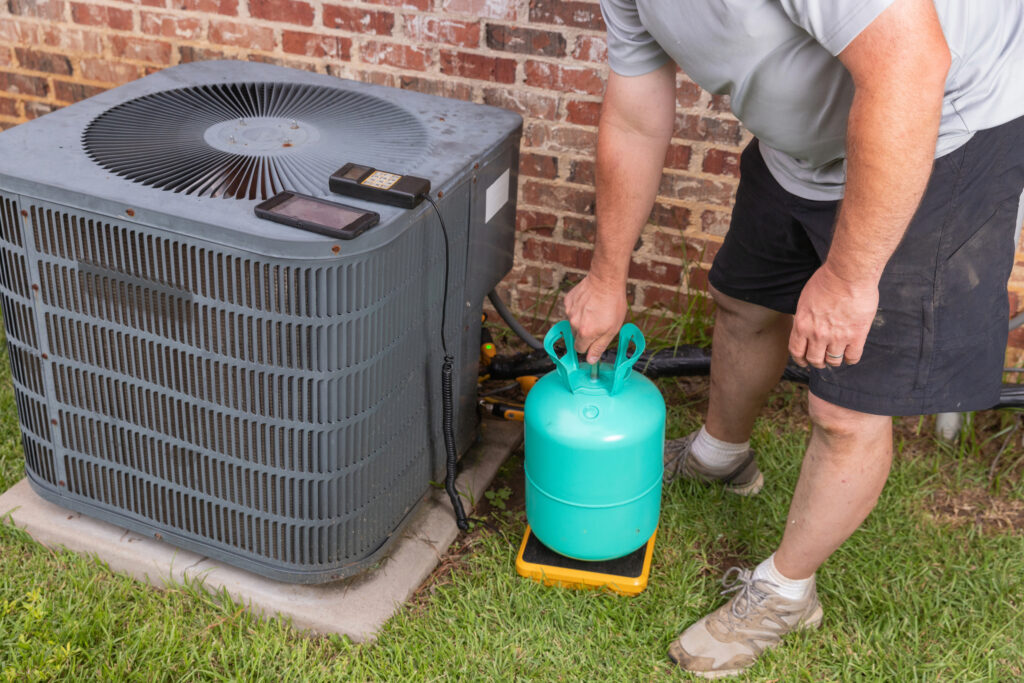With the heightened focus on climate change and sustainability, industries worldwide are undergoing transformations to meet stricter environmental regulations. What does this mean for the HVAC industry? Well, refrigerants are a hot topic, particularly R-410A. As such, we believe it’s crucial for homeowners to become familiar with the ramifications of its possible phase-out.

Role of Refrigerants in HVAC Systems
Refrigerants are essential chemical compounds in air conditioning and heat pumps, pivotal in absorbing and expelling heat to cool or warm spaces. Over time, the HVAC industry has progressed towards refrigerants that aim for efficiency and reduced environmental impact.
Introduced as an environmentally safer replacement for CFCs and HCFCs that harm the ozone layer, R-410A, a hydrofluorocarbon (HFC), still retains a high global warming potential (GWP), prompting authorities to consider its phase-out.
The Shift Towards Eco-Friendly Alternatives
The drive to reduce R-410A usage stems from international agreements targeting lower greenhouse gas emissions. The Kigali Amendment to the Montreal Protocol, enacted in 2016, is a key agreement geared towards cutting HFC use. Developed countries like the United States and European nations intend to reduce HFC consumption to 15-25% of baseline levels by the mid-2030s.
Future Outlook for R-410A
Although a complete ban in 2025 isn’t confirmed, significant steps toward curbing R-410A’s usage are underway:
- Regulatory Policies: Countries are imposing tighter controls on the production and import of R-410A. For example, the European Union’s F-Gas Regulation and the US EPA‘s phasedown programs are in place.
- Industry Adaptations: The HVAC industry is rapidly exploring alternatives with lower GWPs, such as R-32, R-454B, and R-466A, to comply with new regulations.
- Market Evolution: As regulatory landscapes change, manufacturers are transitioning to these newer refrigerants. The shift is driving a market transformation, where producing and updating systems compatible with low-GWP refrigerants is becoming essential.
Alternatives to R-410A
- R-32: With half the GWP and greater energy efficiency than R-410A, R-32 is an attractive substitute. It’s increasingly found in new systems, especially where stringent climate regulations exist.
- R-454B: Known for its balanced characteristics, R-454B boasts a lower GWP and operates under pressures similar to R-410A, simplifying the transition for manufacturers and users.
- R-466A (Solstice N41): Noted for its safety and efficiency, R-466A is non-flammable, offering a safety advantage over some alternatives.
Implications of the Phase-Out
For Manufacturers
Manufacturers must lead this transition, requiring investments in R&D and production line adjustments to develop systems that use eco-friendly refrigerants.
For Consumers
Consumers may experience short-term price increases for systems and services as the market adapts. However, long-term benefits include enhanced efficiency and lowered energy costs from better-performing refrigerants, ultimately cutting utility bills.
For the Environment
Shifting away from high-GWP refrigerants like R-410A is expected to yield environmental benefits. By adopting lower-impact solutions, the HVAC industry contributes to global efforts against climate change, aligning with goals to cut greenhouse gas emissions.

The HVAC industry’s evolution in response to environmental demands highlights the importance of R-410A’s phase-out, moving toward sustainable practices. While 2025 is not set for a complete ban, Pickerington Heating & Cooling is committed to adapting and leading in this transformative period with eco-friendly alternatives for a better future.
If you have questions or concerns regarding your HVAC system’s refrigerant or suspect your own system is due for a refrigerant refill, also known as a “recharge,” please don’t hesitate to contact us. We’ll get you taken care of!
Call Pickerington Heating & Cooling today at (614) 837-4026 or schedule an appointment online now by clicking here!
More HVAC Refrigerant Information
Our goal is always to keep you informed as best as we can. Learn more about the role of HVAC refrigerants and their role here!




